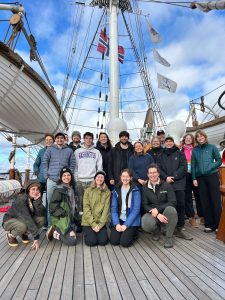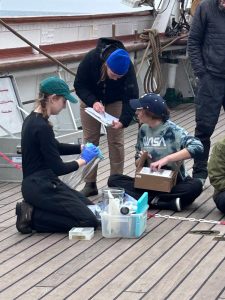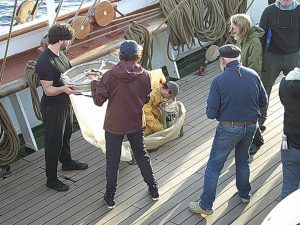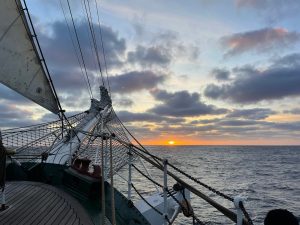The Washington Ocean Acidification Center (WOAC) recently joined the One Ocean Expedition aboard the historic Statsraad Lehmkuhl, a three-masted sailing ship built in 1914. Departing from Seattle’s Pier 66 on October 27th, the ship charted a course south to San Francisco’s Pier 17, arriving on November 3rd. The journey began in the Puget Sound, continued through the Strait of Juan de Fuca, where it paused to ride out a storm off the Washington Coast, before venturing across the continental shelf and traveling south in the Northern California Current. On board were scientists, students, and sailing enthusiasts, all eager to experience a traditional and historic means of traveling the seas.
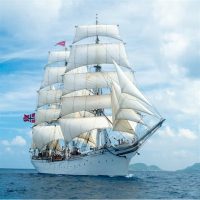
For WOAC phytoplankton biologists, this expedition offered an excellent chance to study the seasonal shift from fall to winter, track how phytoplankton assemblages differ between Puget Sound and offshore waters, and monitor for Harmful Algal Bloom (HAB) species. For this, two cutting-edge techniques were used: Imaging FlowCytobot (IFCB) sampling and environmental DNA (eDNA) sampling. The IFCB continuously sampled throughout the voyage, providing high spatial and temporal resolution of phytoplankton community composition, while eDNA sampling targeted the presence of the HAB species Alexandrium.
HABs are a growing concern in the Pacific Northwest. Species such as Alexandrium produce potent neurotoxins that can accumulate in shellfish, posing risks to human health and leading to costly closures of shellfish harvests. These blooms threaten marine ecosystems, impacting fish, seabirds, and even marine mammals. With climate change and ocean acidification altering ocean conditions, HABs are becoming more frequent and less predictable. Monitoring these events is essential for protecting coastal communities, sustaining fisheries, and ensuring food safety.
By utilizing novel approaches and taking advantage of opportunistic sampling, scientists can continue to advance their understanding of HAB dynamics. Opportunistic sampling augments and expands data collected through more standing monitoring frameworks. Our voyage aboard the Statsraad Lehmkuhl is a good example of this, utilizing the One Ocean Expedition, a global pre-planned voyage, to conduct region-specific ocean monitoring and enabling scientists to collect data that they would not otherwise obtain. A particular bonus was the chance to collect samples while sailing, using wind power in place of carbon-based fuels.
- the sailing crew posing for a photo on the ship
- scientists pour over measurements
- scientists gathering samples
- sunset over the Pacific Ocean
